Reservoir Characteristics and Main Factors Controlling Carboniferous Volcanic Rocks in the Well CH471 Area of the Hongche Fault Zone: Northwest Margin of Junggar Basin, China
Abstract
:1. Introduction
2. Geological Setting
3. Samples and Methods
4. Experimental Results
4.1. Volcanic Reservoir Characteristics of Lithology and Lithofacies
4.2. Volcanic Reservoir Pore Types and Characteristics
4.3. Reservoir Physical Properties
5. Discussion
5.1. Lithology Is the Foundation of Reservoirs
5.2. Fracturing, Weathering, and Leaching Are the Key to Reservoir Formation
5.2.1. Effect of Fracturing on the Reservoir
5.2.2. Effect of Weathering and Leaching on Reservoirs
5.3. Tectonic Movement Is the Basis of Volcanic Reservoir Formation
6. Conclusions
Author Contributions
Funding
Data Availability Statement
Acknowledgments
Conflicts of Interest
References
- Schutter, S.R. Occurrences of Hydrocarbons in and around Igneous Rocks; The Geological Society: London, Britain, 2003; Volume 214, pp. 35–68. [Google Scholar] [CrossRef]
- Nakata, J.K. Distribution and Petrology of the Anderson-Coyote Reservoir Volcanic Rocks, California; Open-File Report—US Geological Survey, No. 80-1256; United States Department of the Interior Geological Survey: Reston, VA, USA, 1980. [CrossRef]
- Sruoga, P.; Rubinstein, N.; Hinterwimmer, G. Porosity and permeability in volcanic rocks: A case study of the Serie Tobifera, South Patgonia, Argentina. J. Volcanol. Geotherm. Res. 2004, 132, 31–43. [Google Scholar] [CrossRef]
- Tang, F.H.; Tian, Z.W.; Gao, Y.F.; Dai, X.J. Review of volcanic reservoir geology in China. Earth-Sci. Rev. 2022, 232, 104158. [Google Scholar] [CrossRef]
- Magara, K. Volcanic reservoir rocks of northwestern Honshu Island, Japan. Geol. Soc. Lond. Spec. Publ. 2003, 214, 69–81. [Google Scholar] [CrossRef]
- Wang, L.; Li, J.H.; Shi, Y.M.; Zhao, Y.; Ma, Y.S. Review and prospect of global volcanic reservoirs. Geol. China 2015, 42, 1610–1620. [Google Scholar] [CrossRef]
- Mao, Z.G.; Zhu, R.K.; Luo, J.L.; Wang, J.H.; Du, Z.H.; Su, L.; Zhang, S.M. Reservoir characteristics, formation mechanisms and petroleum exploration potential of volcanic rocks in China. Pet. Sci. 2015, 12, 54–66. [Google Scholar] [CrossRef]
- Jiang, H.; Shi, Y.; Zhang, Y.; Fan, Z.; Shi, F.; Kou, Y.; Wang, L. Potential of global volcanics-hosted oil-gas resources. Resour. Ind. 2009, 11, 20–22. [Google Scholar] [CrossRef]
- Petford, N.; McCaffrey, K. Hydrocarbons in Crystalline Rocks: An Introduction; The Geological Society: London, Britain, 2003; Volume 214, pp. 1–5. [Google Scholar] [CrossRef]
- Zou, C.N.; Zhao, W.Z.; Jia, C.Z.; Zhu, R.K.; Zhang, G.Y.; Zhao, X.; Yuan, X.J. Formation and distribution of volcanic hydrocarbon reservoirs in sedimentary basins of China. Pet. Explor. Dev. 2008, 35, 257–271. [Google Scholar] [CrossRef]
- Jiang, F.; Cheng, R.H.; Ruan, B.T.; Lin, B.; Xu, Z.J.; Li, Z.C. Formation mechanism of volcanic reservoirs within a volcanostratigraphic framework: The case of the Wangfu fault depression in the Songliao Basin, China. Mar. Pet. Geol. 2017, 84, 160–178. [Google Scholar] [CrossRef]
- Yang, H.; Zhang, Y.; Zou, C.N.; Wen, B.H.; Li, J.Z.; Li, M. Exploration scheme of gas in deep-seated volcanic rocks in Songliao Basin. Pet. Explor. Dev. 2006, 33, 274–281. [Google Scholar] [CrossRef]
- Lin, R.J.; Xu, K.D. The discussion of hydrocarbon in Mesozoic volcanic rocks distributed zone in the eastern parts of Zhejiang, Fujian and Guangdong provinces. Acta Pet. Sin. 1995, 16, 23–30. [Google Scholar] [CrossRef]
- Lu, B.Q.; Zhang, Y.J.; Wang, H.G.; Zhuang, Y.L. Present and Prospect of Cenozoic/Mesozoic Volcanic Rock Oil and Gas Accumulations in East of China. Offshore Oil 2003, 23, 9–13. [Google Scholar] [CrossRef]
- Chen, Z.H.; Liu, W.; Zhang, Y.; Yan, D.T.; Yang, D.S.; Zha, M.; Li, L. Characterization of the paleocrusts of weathered carboniferous volcanics from the Junggar Basin, western China: Significance as gas reservoirs. Mar. Pet. Geol. 2016, 77, 216–234. [Google Scholar] [CrossRef]
- Kuang, L.C.; Xue, X.K.; Zou, C.N.; Hou, L.H. Oil accumulation and concentration regularity of volcanic lithostratigraphic oil reservoir: A case from upper-plate Carboniferous of KA-BAI fracture zone, Junggar Basin. Pet. Explor. Dev. 2007, 34, 285–290. [Google Scholar] [CrossRef]
- Gao, C.H.; Zhang, J.H.; Jiang, R.F. Fault Plugging History and Hydrocarbon Accumulation of Carboniferous Volcanic Rock in the Northwestern Margin of Junggar Basin. J. Xi’an Shiyou Univ. Nat. Sci. Ed. 2018, 7, 1–7. [Google Scholar] [CrossRef]
- Chen, Z.H.; Wang, X.Y.; Wang, X.L.; Zhang, Y.G.; Yang, D.S.; Tang, Y. Characteristics and petroleum origin of the Carboniferous volcanic rock reservoirs in the Shixi Bulge of Junggar Basin, western China. Mar. Pet. Geol. 2017, 80, 517–537. [Google Scholar] [CrossRef]
- Zhu, D.P.; Liu, X.W.; Guo, S.B. Reservoir Formation Model and Main Controlling Factors of the Carboniferous Volcanic Reservoir in the Hong-Che Fault Zone, Junggar Basin. Energies 2020, 13, 6114. [Google Scholar] [CrossRef]
- Zheng, H.; Sun, X.M.; Zhu, D.F.; Tian, J.X.; Wang, P.J.; Zhang, X.Q. Characteristics and factors controlling reservoir space in the Cretaceous volcanic rocks of the Hailar Basin, NE China. Mar. Pet. Geol. 2018, 91, 749–763. [Google Scholar] [CrossRef]
- Sruoga, P.; Rubinstein, N. Processes controlling porosity and permeability in volcanic reservoirs from the Austral and Neuquén basins, Argentina. AAPG Bull. 2007, 91, 115–129. [Google Scholar] [CrossRef]
- Feng, Z.H.; Yin, C.H.; Liu, J.J.; Zhu, Y.K.; Lu, J.M.; Li, J.H. Formation mechanism of in-situ volcanic reservoirs in eastern China: A case study from Xushen gasfield in Songliao Basin. Sci. China-Earth Sci. 2014, 57, 2998–3014. [Google Scholar] [CrossRef]
- Tang, Y.J.; Chen, F.K.; Peng, P. Characteristics of volcanic rocks in Chinese basins and their relationship with oil-gas reservoir forming process. Acta Petrol. Sin. 2010, 26, 185–194. [Google Scholar] [CrossRef]
- Chen, H.Q.; Hu, Y.L.; Jin, J.Q.; Ran, Q.Q.; Yan, L. Fine Stratigraphic Division of Volcanic Reservoir by Uniting of Well Data and Seismic Data-Taking Volcanic Reservoir of Member One of Yingcheng Formation in Xudong Area of Songliao Basin for an Example. J. Earth Sci. 2014, 25, 337–347. [Google Scholar] [CrossRef]
- Zou, C.N.; Zhu, R.K.; Zhao, W.Z.; Jia, C.Z.; Zhang, G.Y.; Yuan, X.J.; Zhao, X.; Wen, B.H. Geologic Characteristics of Volcanic Hydrocarbon Reservoirs and Exploration Directions in China. Acta Geol. Sin.-Engl. Ed. 2010, 84, 194–205. [Google Scholar] [CrossRef]
- Sun, H.T.; Zhong, D.K.; Zhan, W.J. Reservoir characteristics in the Cretaceous volcanic rocks of Songliao Basin, China: A case of dynamics and evolution of the volcano-porosity and diagenesis. Energy Explor. Exploit. 2019, 37, 607–625. [Google Scholar] [CrossRef]
- Du, S.; Shan, X.L.; Yi, J.; Li, J.Y. Controlling factors of high-quality volcanic reservoirs of Yingcheng Formation in the Songnan gas field. J. Cent. South Univ. 2018, 25, 892–902. [Google Scholar] [CrossRef]
- Li, X.L.; Song, M.S.; Lin, H.X.; Zhang, K.H.; Shi, H.G.; Zhang, Y.J.; Hou, D.J. Characteristics of Carboniferous volcanic reservoirs in the Chun-feng Oilfield of the Junggar basin, China. Arab. J. Geosci. 2019, 12, 500. [Google Scholar] [CrossRef]
- Sun, X.M.; Cao, S.Y.; Pan, X.; Hou, X.Y.; Gao, H.; Li, J.B. Characteristics and prediction of weathered volcanic rock reservoirs: A case study of Carboniferous rocks in Zhongguai paleouplift of Junggar Basin, China. Interpret.-A J. Subsurf. Charact. 2018, 6, T431–T447. [Google Scholar] [CrossRef]
- Fan, C.H.; Li, H.; Qin, Q.R.; Shang, L.; Yuan, Y.F.; Li, Z. Formation mechanisms and distribution of weathered volcanic reservoirs: A case study of the carboniferous volcanic rocks in Northwest Junggar Basin, China. Energy Sci. Eng. 2020, 8, 2841–2858. [Google Scholar] [CrossRef]
- Li, H.; Tang, H.M.; Qin, Q.R.; Fan, C.H.; Han, S.; Yang, C.; Zhong, C. Reservoir characteristics and hydrocarbon accumulation of Carboniferous volcanic weathered crust of Zhongguai high area in the western Junggar Basin, China. J. Cent. South Univ. 2020, 8, 2841–2858. [Google Scholar] [CrossRef]
- Zhang, K.L.; Wang, Z.L.; Jiang, Y.Q.; Wang, A.G.; Xiang, B.L.; Zhou, N.; Wang, Y. Effects of weathering and fracturing on the physical properties of different types of volcanic rock: Implications for oil reservoirs of the Zhongguai relief, Junggar Basin, NW China. J. Pet. Sci. Eng. 2020, 193, 107351. [Google Scholar] [CrossRef]
- Tian, M.; Xu, H.M.; Cai, J.; Wang, J.; Wang, Z.Z. Artificial neural network assisted prediction of dissolution spatial distribution in the volcanic weathered crust: A case study from Chepaizi Bulge of Junggar Basin, northwestern China. Mar. Pet. Geol. 2019, 110, 928–940. [Google Scholar] [CrossRef]
- Zhou, L.; Zhou, K.; Wang, G. Distribution features and main controlling factors of volcanic buried hill reservoirs in carboniferous basement of Junggar Basin. Arab. J. Geosci. 2021, 13, 1297. [Google Scholar] [CrossRef]
- Ma, S.W.; Luo, J.L.; He, X.Y.; Xu, X.L.; Dai, J.J. The influence of fracture development on quality and distribution of volcanic reservoirs: A case study from the carboniferous volcanic reservoirs in the Xiquan area, eastern Junggar Basin. Arab. J. Geosci. 2019, 12, 110. [Google Scholar] [CrossRef]
- Zhou, Y.M. The Gravitational and Magnetic Field Research of Carboniferous Volcanic Rocks in Western-Central Junggar Basin. Ph.D. Thesis, Nanjing University, Nanjing, China, 2018. [Google Scholar]
- Liang, Y.S. Geological Structure, Formation and Evolution of Chepaizi Uplift in Western Junggar Basin. Ph.D. Thesis, China University of Geosciences, Beijing, China, 2019. [Google Scholar]
- Wang, J.; Chen, J.; Chen, R.B.; Liu, X.J.; Liu, J.; Lian, L.X.; Ma, C. Forming environment of Carboniferous volcanic rocks and its influence mechanism on reservoir performance in the eastern Junggar Basin. Nat. Gas Geosci. 2022, 33, 1785–1797. [Google Scholar]
- Jiao, X.Q.; Zhang, G.L.; Niu, H.P.; Wang, S.Z. Genesis of Carboniferous volcanic rocks in northeastern Junggar Basin: New insights into the Junggar Ocean closure. Earth Sci. Front. 2022, 29, 385–402. [Google Scholar] [CrossRef]
- Yiming, A.; Bian, B.L.; Liu, L.S.; Chen, H.L.; Shan, X.L.; Li, A. Types and Eruption Patterns of the Carboniferous Volcanic Edifices in the Shixi Area, Junggar Basin. Front. Earth Sci. 2022, 10, 906782. [Google Scholar] [CrossRef]
- Mao, L.X.; Chang, X.C.; Xu, Y.D.; Shi, B.B.; Gao, D.K. Geochemical characterization and possible hydrocarbon contribution of the Carboniferous interval natively developed in the Chepaizi Uplift of Junggar Basin, northwestern China. Energy Explor. Exploit. 2020, 38, 654–681. [Google Scholar] [CrossRef]
- He, D.F.; Yi, C.; Du, S.K.; Shi, X.; Ma, H.S. Characteristics of structural segmentation of foreland thrust belts—A case study of the fault belts in the northwestern margin of Junggar Basin. Earth Sci. Front. 2004, 11, 91–101. [Google Scholar]
- Meng, J.F.; Guo, Z.J.; Fang, S.H. A new insight into the thrust structures at the northwestern margin of Junggar Basin. Earth Sci. Front. 2009, 35, 55–67. [Google Scholar] [CrossRef]
- Yu, Y.L.; Wang, X.; Rao, G.; Wang, R.F. Mesozoic reactivated transpressional structures and multi-stage tectonic deformation along the Hong-Che fault zone in the northwestern Junggar Basin, NW China. Tectonophysics 2016, 679, 156–168. [Google Scholar] [CrossRef]
- Sui, F.G. Tectonic Evolution and Its Relationship with Hydrocarbon Accumulation in the Northwest Margin of Junggar Basin. Acta Geol. Sin. 2015, 89, 779–793. [Google Scholar] [CrossRef]
- Yu, Y.L. Mesozoic Strike-slip Structure and Tectonic Evolution of Hong-Che Fault Zone in the Northwest margin of Junggar Basin, XinJiang, China. Ph.D. Thesis, Zhejiang University, Hangzhou, China, 2016. [Google Scholar]
- Ji, Y.L.; Zhou, Y.; Kuang, J.; Wan, L.; Zhang, R.; Lu, C.H. The formation and evolution of Chepaizi-Mosuowan paleo-uplift and its control on the distributions of sedimentary facies in the Junggar Basin. Sci. China-Earth Sci. 2010, 53, 818–831. [Google Scholar] [CrossRef]
- Yao, W.J.; Dang, Y.F.; Zhang, S.C.; Zhi, D.M.; Xing, C.Z.; Shui, J.A. Formation of Carboniferous Reservoir in Hongche Fault Belt, Northwestern Margin of Junggar Basin. Nat. Gas Geosci. 2010, 21, 917–923. [Google Scholar] [CrossRef]
- SY/T 5830-1993; Description Method of Volcanic Rock Reservoir. Oil and Gas Industry Standards of the People’s Republic of China: Beijing, China, 1993.
- Tang, F.H.; Wang, P.J.; Bian, W.H.; Huang, Y.L.; Gao, Y.F.; Dai, X.J. Review of volcanic reservoir geology. Acta Pet. Sin. 2020, 41, 1744–1773. [Google Scholar] [CrossRef]
- Li, H.; Tang, H.M.; Qin, Q.R.; Zhou, J.L.; Qin, Z.J.; Fan, C.H.; Su, P.D.; Wang, Q.; Zhong, C. Characteristics, formation periods and genetic mechanisms of tectonic fractures in the tight gas sandstones reservoir: A case study of Xujiahe Formation in YB area, Sichuan Basin, China. J. Pet. Sci. Eng. 2019, 178, 723–735. [Google Scholar] [CrossRef]
- Wang, J.; Wang, X.L. Seepage characteristic and fracture development of protected seam caused by mining protecting strata. J. Min. Strat. Control Eng. 2021, 3, 033511. [Google Scholar] [CrossRef]
- Li, J.; Li, H.; Yang, C.; Ren, X.H.; Li, Y.D. Geological characteristics of deep shale gas and their effects on shale fracability in the Wufeng–Longmaxi Formations of the southern Sichuan Basin, China. Lithosphere 2023, 2023, 4936993. [Google Scholar] [CrossRef]
- Shan, S.C.; Wu, Y.Z.; Fu, Y.K.; Zhou, P.H. Shear mechanical properties of anchored rock mass under impact load. J. Min. Strat. Control Eng. 2021, 3, 043034. [Google Scholar] [CrossRef]
- Li, H.; Wang, Q.; Qin, Q.R.; Ge, X.Y. Characteristics of natural fractures in an ultradeep marine carbonate gas reservoir and their impact on the reservoir: A case study of the Maokou Formation of the JLS Structure in the Sichuan Basin, China. Energy Fuels 2021, 35, 13098–13108. [Google Scholar] [CrossRef]
- Puffer, J.H.; Laskowich, C. Volcanic diapirs in the Orange Mountain flood basalt: New Jersey, USA. J. Volcanol. Geotherm. Res. 2012, 237, 1–9. [Google Scholar] [CrossRef]
- Nabawy, B.S.; Wassif, N.A. Effect of the mineralogical composition on the petrophysical behavior of the amygdaloidal and vesicular basalt of Wadi Wizr, Eastern Desert, Egypt. J. Afr. Earth Sci. 2017, 134, 613–625. [Google Scholar] [CrossRef]
- Huang, Q.F.; Dou, Q.F.; Sun, Y.F. Characterization of Pore Structure Variation and Permeability Heterogeneity in Carbonate Rocks Using MICP and Sonic Logs: Puguang Gas Field, China. Petrophysics 2018, 58, 576–591. [Google Scholar]
- Ren, Z.W.; Jin, C.S. Reservoir space feature of the volcanic rocks in the area of Well Wa 609, Liaohe sag. Pet. Explor. Dev. 1999, 26, 54–56. [Google Scholar] [CrossRef]
- Li, H.; Tang, H.M.; Qin, Q.R.; Wang, Q.; Zhong, C. Effectiveness evaluation of natural fractures in Xujiahe Formation of Yuanba area, Sichuan basin, China. Arab. J. Geosci. 2019, 12, 194. [Google Scholar] [CrossRef]
- Wang, S.L.; Li, H.; Lin, L.F.; Yin, S. Development characteristics and finite element simulation of fractures in tight oil sandstone reservoirs of Yanchang Formation in western Ordos Basin. Front. Earth Sci. 2022, 9, 823855. [Google Scholar] [CrossRef]
- Li, J.J.; Qin, Q.R.; Li, H.; Wan, Y.F. Numerical simulation of the stress field and fault sealing of complex fault combinations in Changning area, southern Sichuan Basin, China. Energy Sci. Eng. 2022, 10, 278–291. [Google Scholar] [CrossRef]
- Ndiaye, M.; Ngom, P.M.; Gorin, G.; Villeneuve, M.; Sartori, M.; Medou, J. A new interpretation of the deep-part of Senegal-Mauritanian Basin in the Diourbel-Thies area by integrating seismic, magnetic, gravimetric and borehole data: Implication for petroleum exploration. J. Afr. Earth Sci. 2016, 121, 330–341. [Google Scholar] [CrossRef]
- Villeneuve, M.; Theveniaut, H.; Ndiaye, P.M.; Retière, S. Re-assessment of the northern Guinean “Koubia-Lessere unconformity” (KLU): Consequences on the geological correlations throughout West Africa. Comptes Rendus Geosci. 2014, 346, 262–272. [Google Scholar] [CrossRef]
- He, S.; Qin, Q.R.; Li, H.; Zhao, S.X. Geological characteristics of deep shale gas in the Silurian Longmaxi Formation in the southern Sichuan Basin, China. Front. Earth Sci. 2022, 9, 818543. [Google Scholar] [CrossRef]
- Liu, J.W.; Zhou, G.L.; Wu, N. Weakening effect of artificial fracture morphology on the tensile strength and energy accumulation of coal. J. Min. Strat. Control Eng. 2022, 4, 053011. [Google Scholar] [CrossRef]
- Villeneuve, M.; Wazi, N.; Kalikone, C.; Gärtner, A. A review of the G4 “tin granites” and associated mineral occurrences in the Kivu Belt (Eastern Democratic Republic of the Congo) and their relationships with the last Kibaran tectono-thermal events. Minerals 2022, 12, 737. [Google Scholar] [CrossRef]
- Zhang, Z.H.; Yu, H.G.; Chen, H.Y.; Du, S.K.; Li, C. Quantitative characterization of fracture-pore distribution and effects on production capacity of weathered volcanic crust reservoirs: Insights from volcanic gas reservoirs of the Dixi area, Junggar Basin, Western China. Mar. Pet. Geol. 2022, 140, 105651. [Google Scholar] [CrossRef]
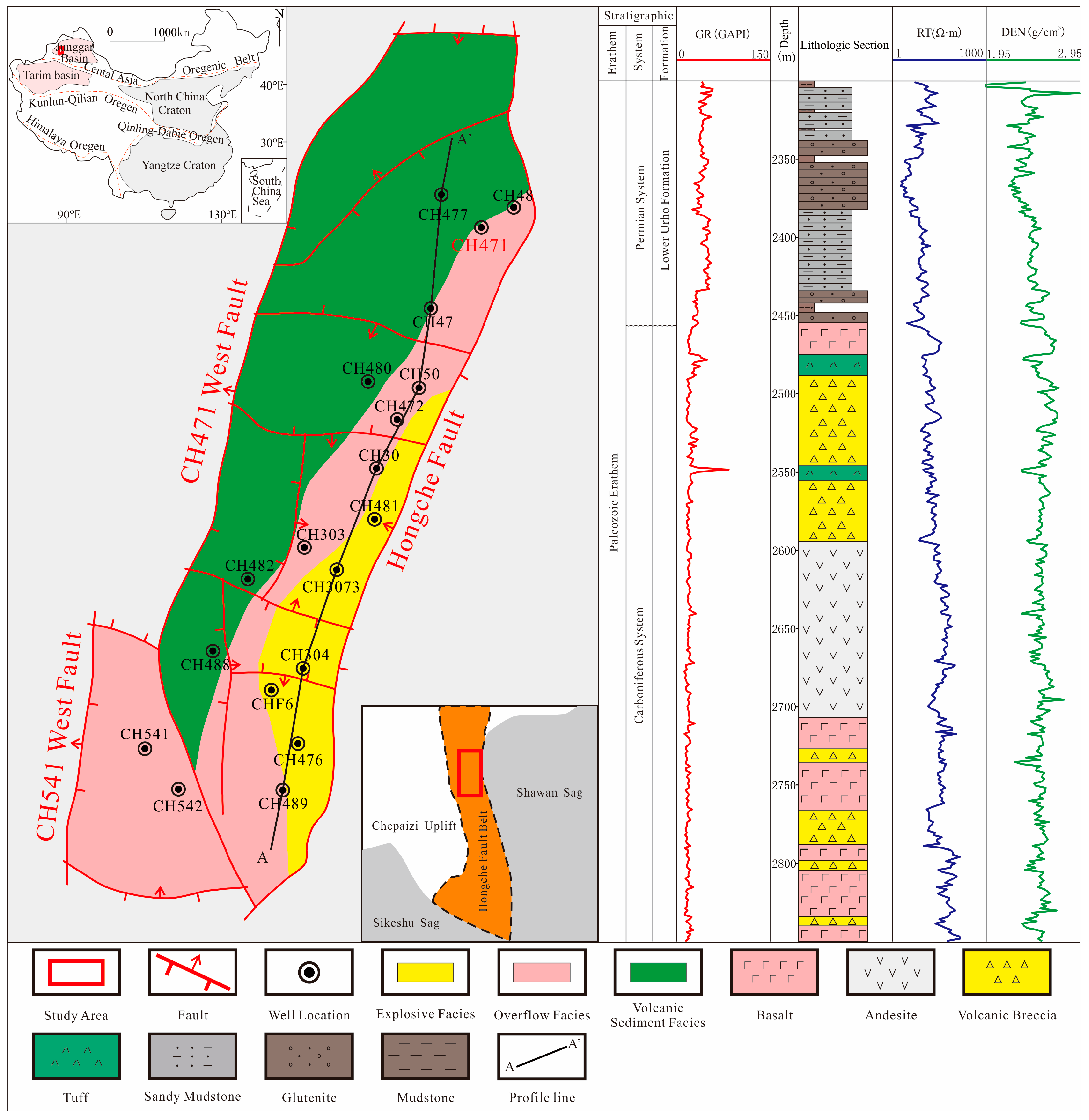
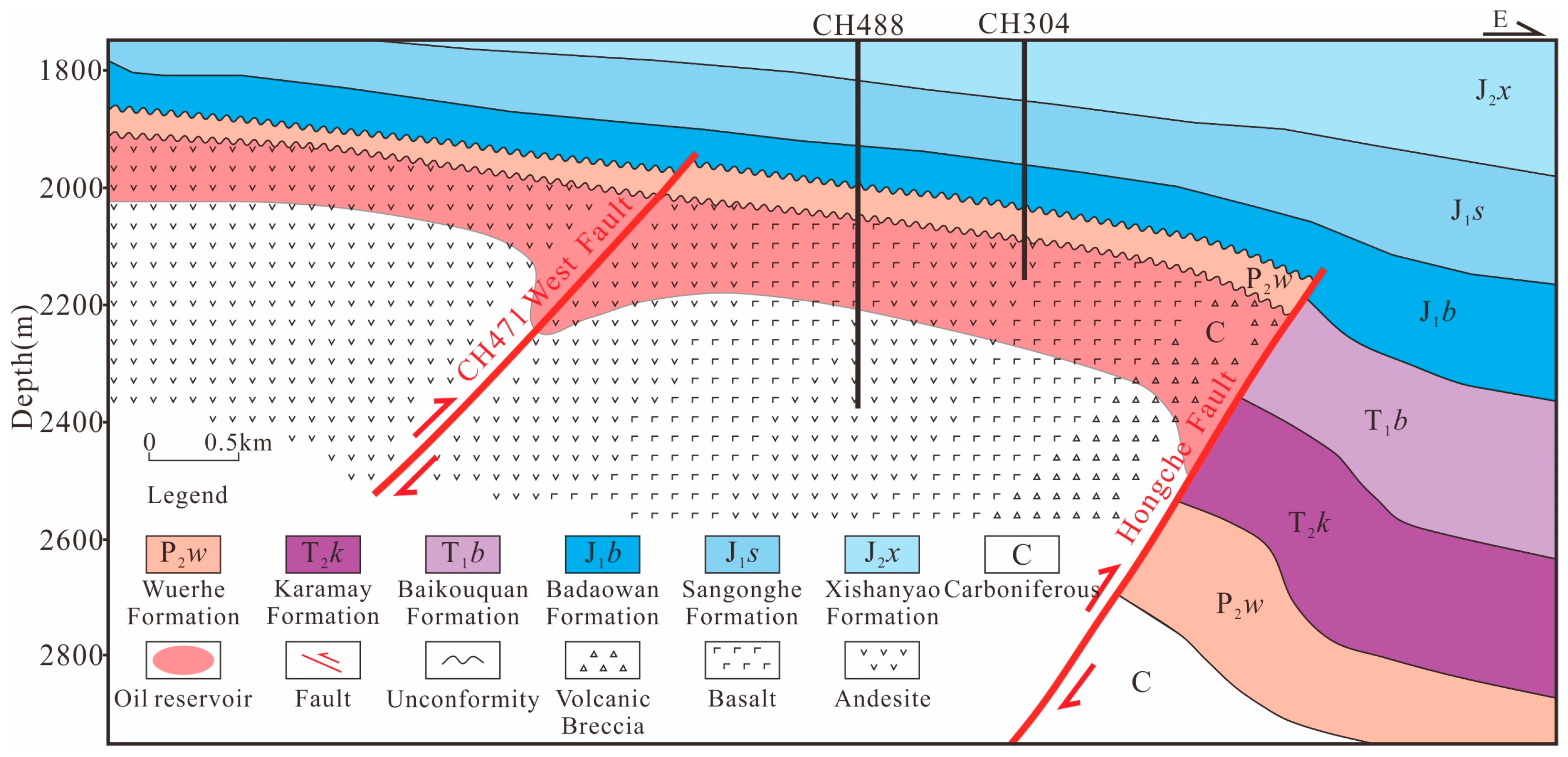

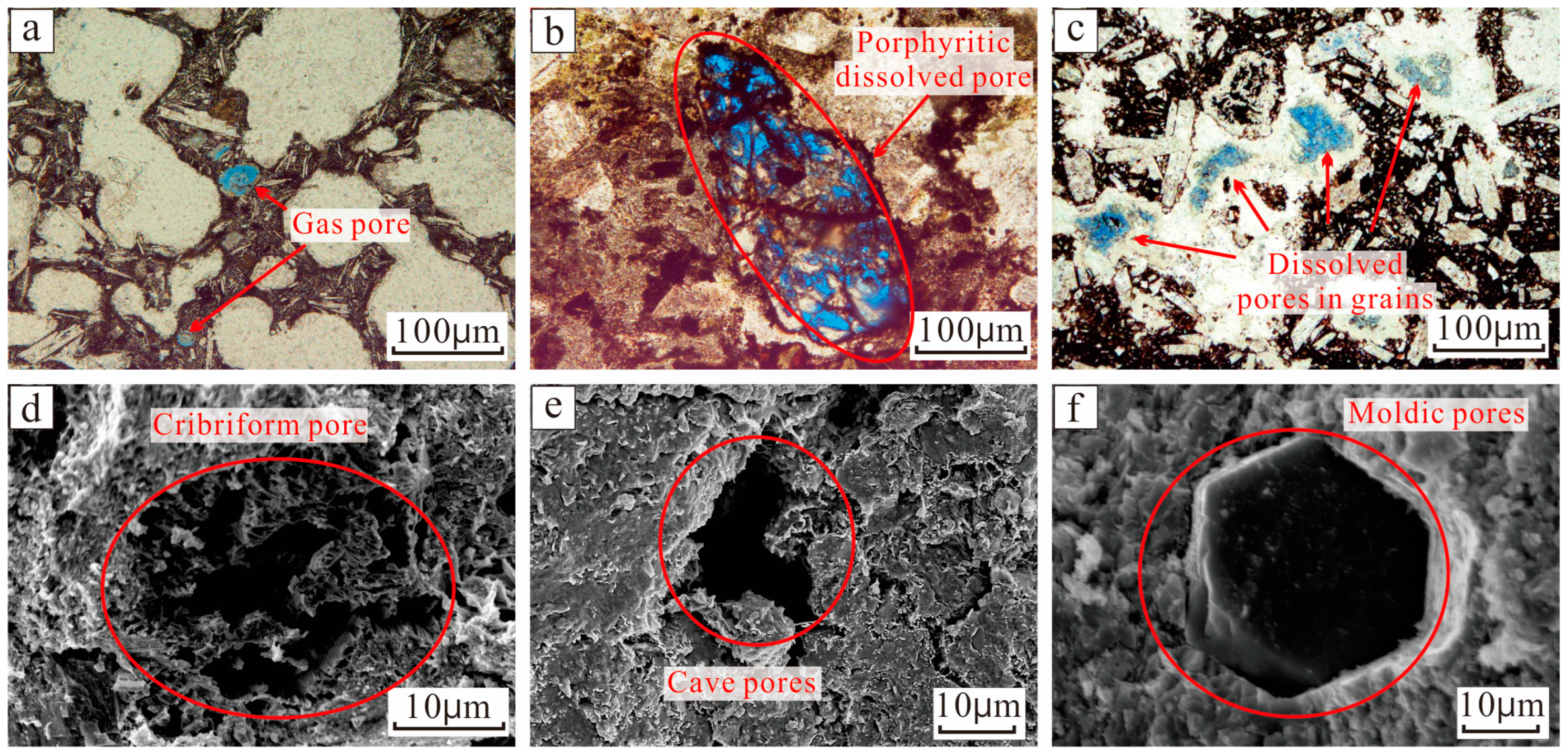

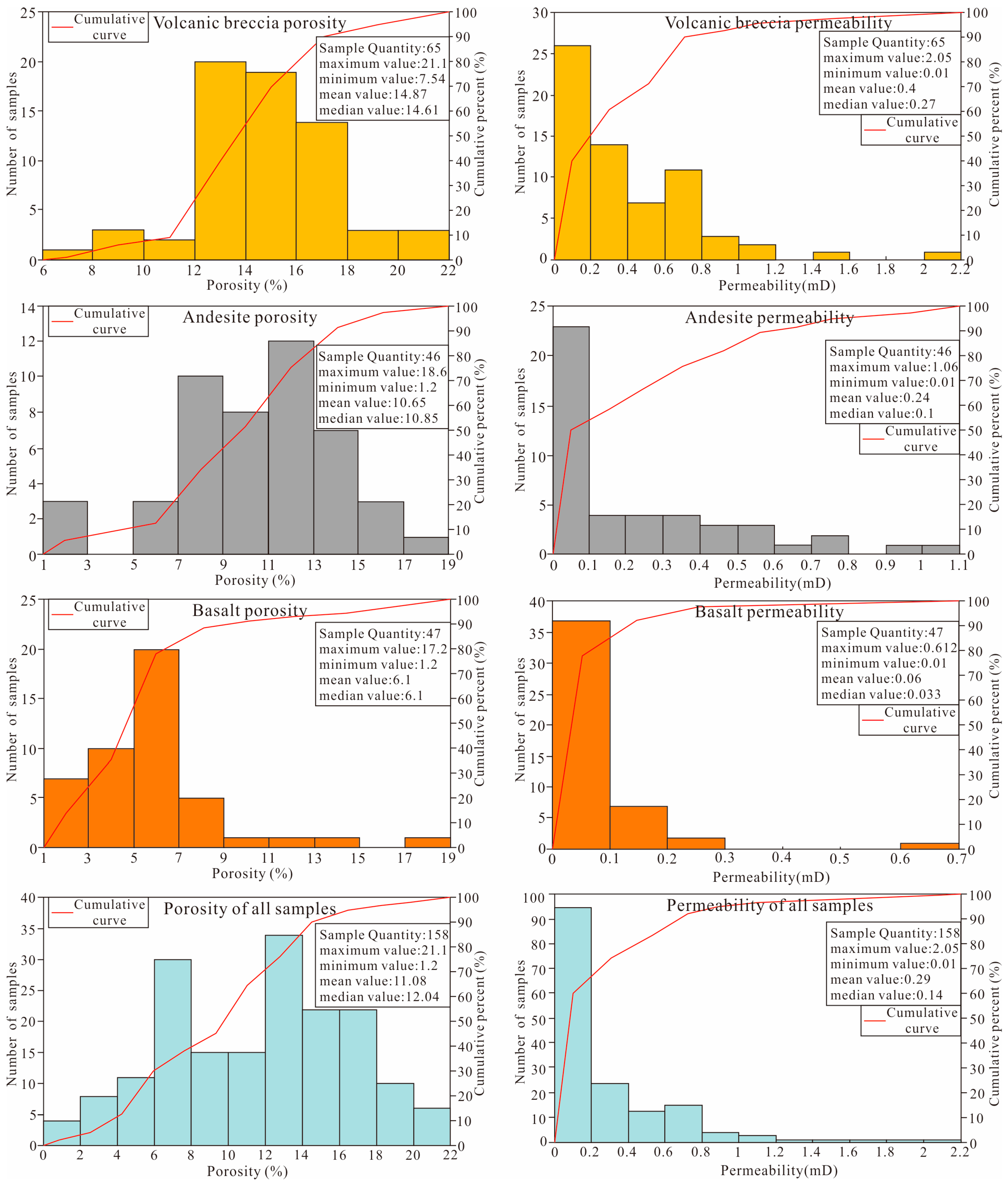
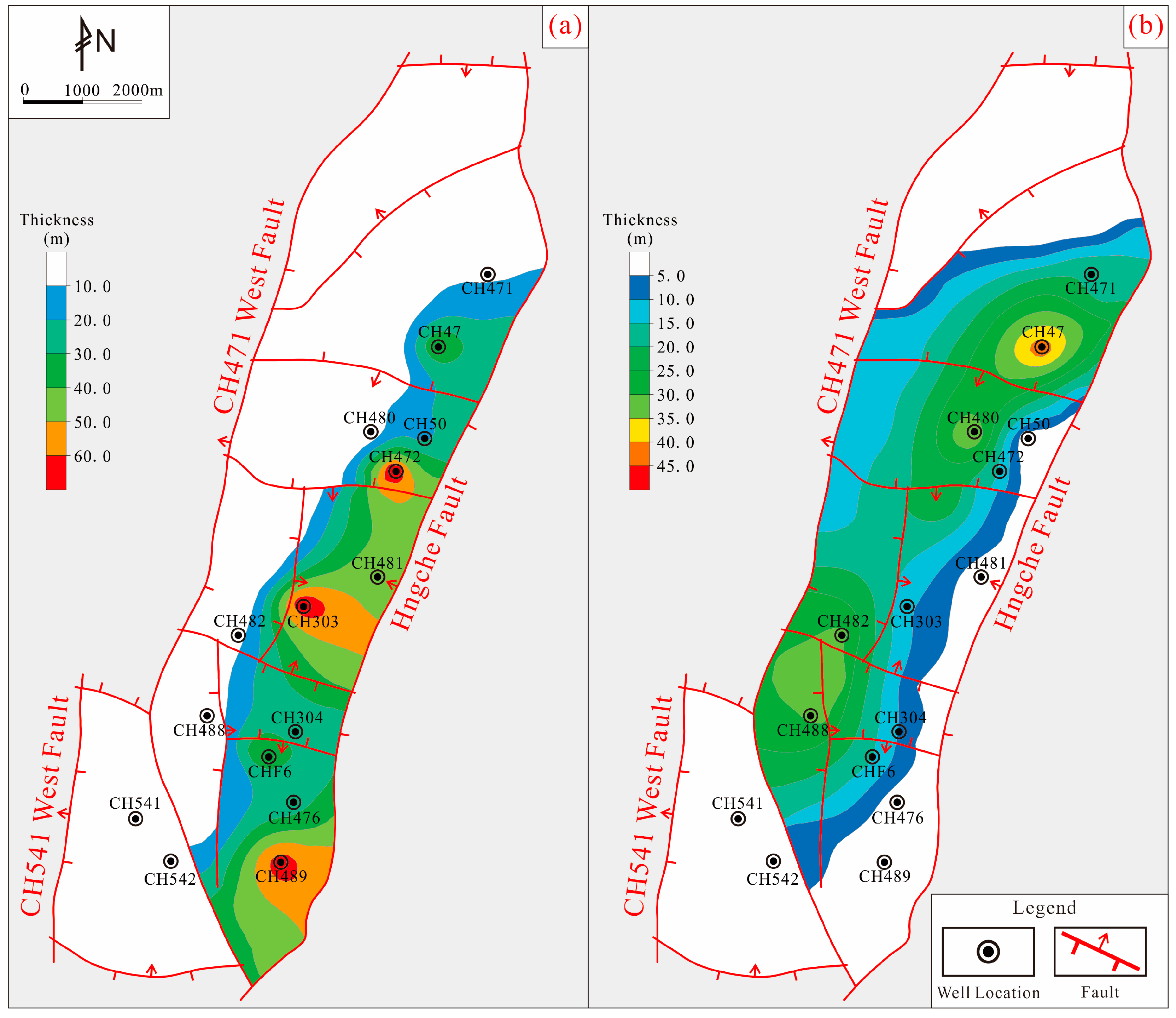

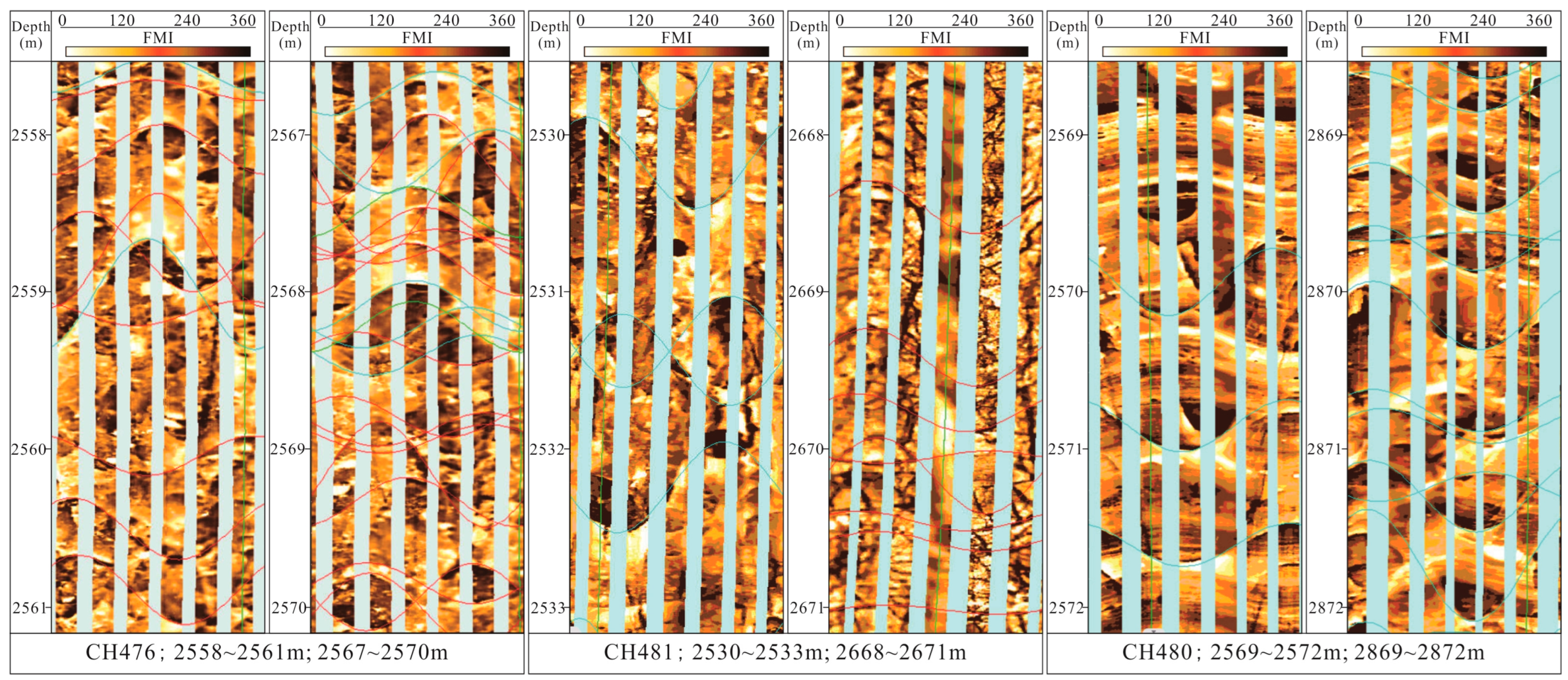

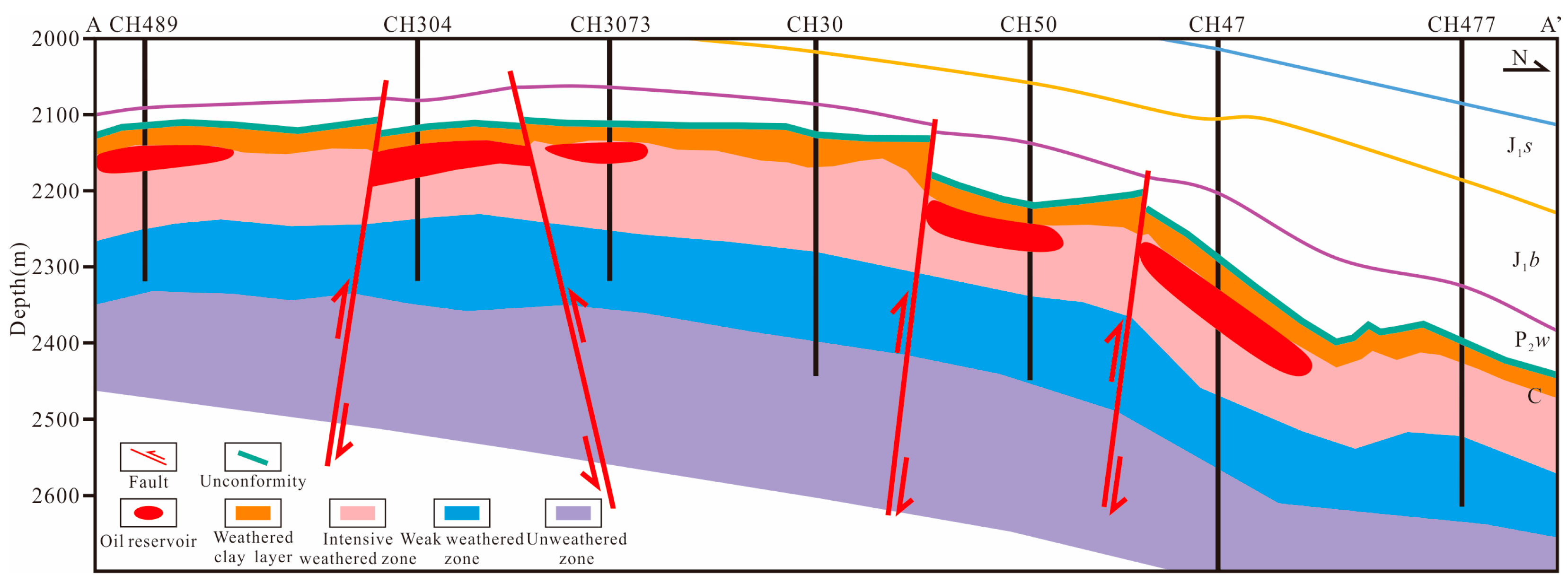
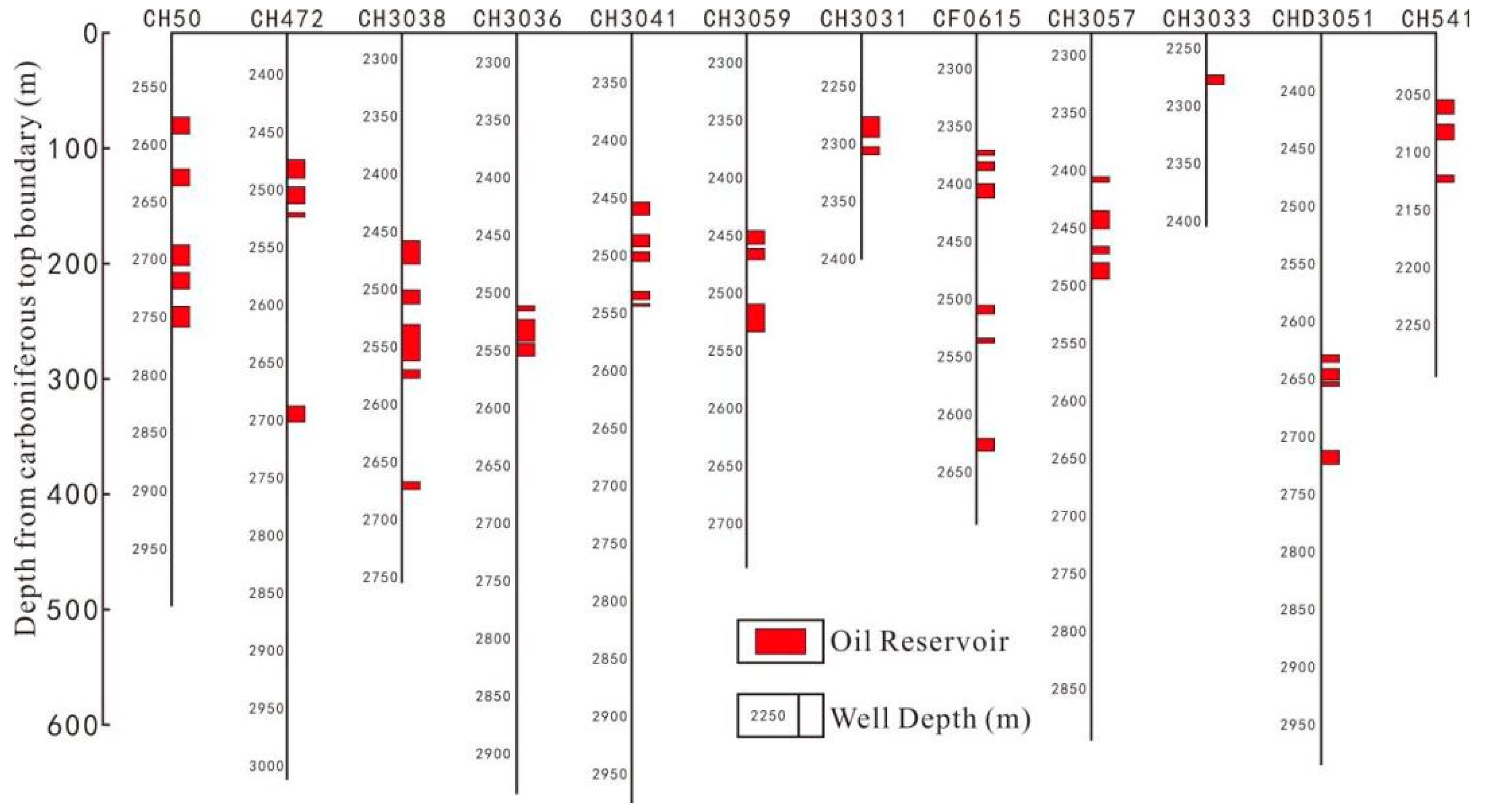
| Well | Volcanic Breccia Reservoir (m) | Volcanic Breccia Oil Test (t/Day) | Andesite Reservoir (m) | Andesite Oil Test (t/Day) | Basalt Reservoir (m) | Basalt Oil Test (t/Day) |
|---|---|---|---|---|---|---|
| CH471 | 0 | 0 | 10 | 4.45 | 24 | 10.69 |
| CH472 | 68 | 31.45 | 0 | 0 | 14 | 4.01 |
| CH476 | 23 | 10 | 0 | 0 | 0 | 0 |
| CH480 | 0 | 0 | 4.5 | 2.92 | 28.5 | 18.21 |
| CH481 | 47 | 38.47 | 0 | 0 | 0 | 0 |
| CH482 | 0 | 0 | 0 | 0 | 29 | 26.26 |
| CH488 | 0 | 0 | 0 | 0 | 30 | 18.71 |
| CH489 | 64 | 14.72 | 0 | 0 | 0 | 0 |
| CH47 | 39 | 25.94 | 42.1 | 20.075 | 0 | 0 |
| CH50 | 18 | 13.86 | 0 | 0 | 0 | 0 |
| CHF6 | 38 | 21.09 | 0 | 0 | 14 | 3.89 |
| CH303 | 64 | 18.66 | 0 | 0 | 11 | 17.58 |
| CH304 | 27 | 18.02 | 0 | 0 | 9 | 4.3 |
| Sum | 388 | 192.21 | 56.6 | 27.445 | 159.5 | 103.65 |
Disclaimer/Publisher’s Note: The statements, opinions and data contained in all publications are solely those of the individual author(s) and contributor(s) and not of MDPI and/or the editor(s). MDPI and/or the editor(s) disclaim responsibility for any injury to people or property resulting from any ideas, methods, instructions or products referred to in the content. |
© 2023 by the authors. Licensee MDPI, Basel, Switzerland. This article is an open access article distributed under the terms and conditions of the Creative Commons Attribution (CC BY) license (https://creativecommons.org/licenses/by/4.0/).
Share and Cite
Chen, Z.; Qin, Q.; Li, H.; Zhou, J.; Wang, J. Reservoir Characteristics and Main Factors Controlling Carboniferous Volcanic Rocks in the Well CH471 Area of the Hongche Fault Zone: Northwest Margin of Junggar Basin, China. Minerals 2023, 13, 1455. https://doi.org/10.3390/min13111455
Chen Z, Qin Q, Li H, Zhou J, Wang J. Reservoir Characteristics and Main Factors Controlling Carboniferous Volcanic Rocks in the Well CH471 Area of the Hongche Fault Zone: Northwest Margin of Junggar Basin, China. Minerals. 2023; 13(11):1455. https://doi.org/10.3390/min13111455
Chicago/Turabian StyleChen, Zhengyu, Qirong Qin, Hu Li, Jiling Zhou, and Jie Wang. 2023. "Reservoir Characteristics and Main Factors Controlling Carboniferous Volcanic Rocks in the Well CH471 Area of the Hongche Fault Zone: Northwest Margin of Junggar Basin, China" Minerals 13, no. 11: 1455. https://doi.org/10.3390/min13111455







